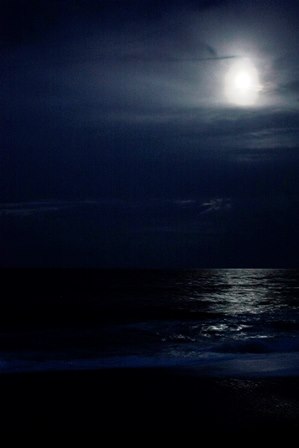 Back from a lovely week with the family at the Outer Banks. While there, I always think about pirates and researched the infamous Blackbeard who fell in a fierce battle off Ocracoke Island in 1718, a favorite pirate hangout. A site called Haunted American Tours has some intriguing info on Blackbeard. “…his flag is not the traditional “Skull & Crossbones” now almost universally accepted as the flag of piracy. It contained the devil or a horned skeleton holding a spear and hour glass and a bleeding heart. Blackbeard’s original name possibly was Edward Drummond, and he likely was born around 1680. A native of Bristol, England, after he became a pirate he called himself Edward Teach, which most records show as Thatch, Tache or Tatch…
Back from a lovely week with the family at the Outer Banks. While there, I always think about pirates and researched the infamous Blackbeard who fell in a fierce battle off Ocracoke Island in 1718, a favorite pirate hangout. A site called Haunted American Tours has some intriguing info on Blackbeard. “…his flag is not the traditional “Skull & Crossbones” now almost universally accepted as the flag of piracy. It contained the devil or a horned skeleton holding a spear and hour glass and a bleeding heart. Blackbeard’s original name possibly was Edward Drummond, and he likely was born around 1680. A native of Bristol, England, after he became a pirate he called himself Edward Teach, which most records show as Thatch, Tache or Tatch…
(Image of full moon over the water by Elise)
Some accounts claim that he had as many as fourteen wives, most of them common-law, but documentation is lacking. His last wife was Mary Ormond (or Ormand) of Bath, North Carolina, to whom he was married for only a short while. A painting of him hangs in Van Der Veer House (ce. 1790), in Bath. Blackbeard often fought with, or simply showed himself wearing, a big feathered tricorn, and having multiple swords, knives, and pistols at his disposal. It was said that he had hemp and lighted matches woven into his enormous black beard during battle. Accounts of people who saw him fighting say that they thought he “looked like the devil” with his fearsome face and the smoke cloud around his head. This image, which he cultivated, has made him the premier image of the seafaring pirate.”

The site also says: “Blackbeard, a British pirate, received his name from his habit of braiding his long, black beard and tying the braids with ribbon. Few pirates have looked and acted as fierce as Blackbeard. Blackbeard carried three braces of pistols. He made himself look devilish in the thick of fighting by sticking long, lighted matches under his hat, framing his face in fire. If action was slow, Blackbeard stirred things up by lighting pots of sulfur in his own ship, or shooting off pistols beneath the table while entertaining friends in his darkened cabin. His journal states that confusion and plotting developed if his men were sober, but all went well when they had enough rum. Blackbeard terrorized the Carolina and Virginia coasts during 1717 and 1718 in his ship, the Queen Anne’s Revenge. In 1717, he blockaded Charleston, South Carolina. He captured ships in the harbor and seized citizens for ransom. Blackbeard left after he received a chest of medicine as ransom. After this raid, he ran his ship aground near Cape Fear, North Carolina. Blackbeard then received a general pardon from Governor Charles Eden of North Carolina, whom he probably bribed. Life on land was not for Blackbeard, and he quickly returned to the sea.
(Below Sunset at the Outer Banks, Image by Elise)
 Blackbeard took such a toll of shipping and created so much terror along the American coast that Virginia and Carolina planters organized against him. The Virginia governor sent the ship H.M.S. Pearl out to take him alive or dead. Blackbeard was caught on Nov. 21, 1718, near Ocracoke Inlet, off the North Carolina coast. He fought desperately with sword and pistol until he fell with 25 wounds in his body. His head was taken back to Virginia and displayed on a pole.” On the eve of that final battle, “thinking it likely they would all die, one pirate asked Blackbeard whether Blackbeard’s wife knew where he had buried his treasure. Blackbeard bellowed that nobody but he “…and the devil knew where it was, and the longest liver shall take it…When Blackbeard died, the secret of his treasure died, too-if indeed he ever had one.”
Blackbeard took such a toll of shipping and created so much terror along the American coast that Virginia and Carolina planters organized against him. The Virginia governor sent the ship H.M.S. Pearl out to take him alive or dead. Blackbeard was caught on Nov. 21, 1718, near Ocracoke Inlet, off the North Carolina coast. He fought desperately with sword and pistol until he fell with 25 wounds in his body. His head was taken back to Virginia and displayed on a pole.” On the eve of that final battle, “thinking it likely they would all die, one pirate asked Blackbeard whether Blackbeard’s wife knew where he had buried his treasure. Blackbeard bellowed that nobody but he “…and the devil knew where it was, and the longest liver shall take it…When Blackbeard died, the secret of his treasure died, too-if indeed he ever had one.” ***I’ll bet he had a treasure, but need more specifics.Regarding his ghost, the site says: “Blackbeard’s head was severed from his body in that famous battle. Afterwards Maynard unceremoniously threw the headless corpse overboard where it reportedly swam around the ship seven times before sinking into the depths of Davey Jones’ Locker… But his skull was the stuff that haunted Pirate legends are made of.” “Maynard carried Blackbeard’s head back to Williamsburg, Virginia as a grim message to Teach’s nefarious “Brethren of the Coast.” R.E. Lee’s book, Blackbeard the Pirate, A Reappraisal of His Life and Times,”according to the legends of Virginia and the statements of a number of writers, Blackbeard’s skull dangled from a high pole on the west side of the mouth of the Hampton River for many years as a warning to seafarers. The place is still today called “Blackbeard’s Point.”
***I’ll bet he had a treasure, but need more specifics.Regarding his ghost, the site says: “Blackbeard’s head was severed from his body in that famous battle. Afterwards Maynard unceremoniously threw the headless corpse overboard where it reportedly swam around the ship seven times before sinking into the depths of Davey Jones’ Locker… But his skull was the stuff that haunted Pirate legends are made of.” “Maynard carried Blackbeard’s head back to Williamsburg, Virginia as a grim message to Teach’s nefarious “Brethren of the Coast.” R.E. Lee’s book, Blackbeard the Pirate, A Reappraisal of His Life and Times,”according to the legends of Virginia and the statements of a number of writers, Blackbeard’s skull dangled from a high pole on the west side of the mouth of the Hampton River for many years as a warning to seafarers. The place is still today called “Blackbeard’s Point.”
~ For more on Blackbeard’s lost skull click here:
In 1997, researchers claimed to have found the remains of Blackbeard’s ship Queen Anne’s Revenge near the coast of North Carolina. Regarding his sunken ship, SmithsonianMag.com says: “…after nearly 300 years in the North Carolina shallows, the remains of what may be the Queen Anne’s Revenge are surfacing, plank by worm-eaten plank. The site, discovered in 1996, is 25 feet underwater, less than a mile and a half from shore. But long weather delays during diving seasons and uncertain funding have slowed the excavation—this past fall’s expedition was the first since 2008—and it can take years to clean and analyze artifacts corroded beyond recognition. Still, with objects recovered from 50 percent of the site, archaeologists are increasingly confident that the wreck is the infamous frigate that terrorized the Caribbean and once blockaded Charleston, South Carolina, for a week before running aground in June 1718. “We’re not going to find anything that says ‘Queen Anne’s Revenge’ or ‘Blackbeard Was Here,’” says Wendy Welsh, manager of the state-run Queen Anne’s Revenge Conservation Laboratory in Greenville, North Carolina. “You have to use all these little clues.”
 “In the commonwealth of Pirates,” concluded novelist Daniel Defoe writing under the nom de plume of Captain Charles Johnson in 1724, “who goes the greatest length for wickedness is looked upon with a kind of envy amongst them, as a person of a more extraordinary gallantry, and is thereby entitled to be distinguished by some post. And if such a one has but courage, he must certainly be a great man.” Blackbeard has been described as “the embodiment of impregnable wickedness, of reckless daring, a nightmarish villain so lacking in any human kindness that no crime was above him. . . the living picture of an ogre who roamed the seas and withered all before him with his very presence.” He was, an 18th-century writer said, like “a frightful meteor” that “frightened America more than any comet that has appeared there in a long time.”
“In the commonwealth of Pirates,” concluded novelist Daniel Defoe writing under the nom de plume of Captain Charles Johnson in 1724, “who goes the greatest length for wickedness is looked upon with a kind of envy amongst them, as a person of a more extraordinary gallantry, and is thereby entitled to be distinguished by some post. And if such a one has but courage, he must certainly be a great man.” Blackbeard has been described as “the embodiment of impregnable wickedness, of reckless daring, a nightmarish villain so lacking in any human kindness that no crime was above him. . . the living picture of an ogre who roamed the seas and withered all before him with his very presence.” He was, an 18th-century writer said, like “a frightful meteor” that “frightened America more than any comet that has appeared there in a long time.”
No comments:
Post a Comment